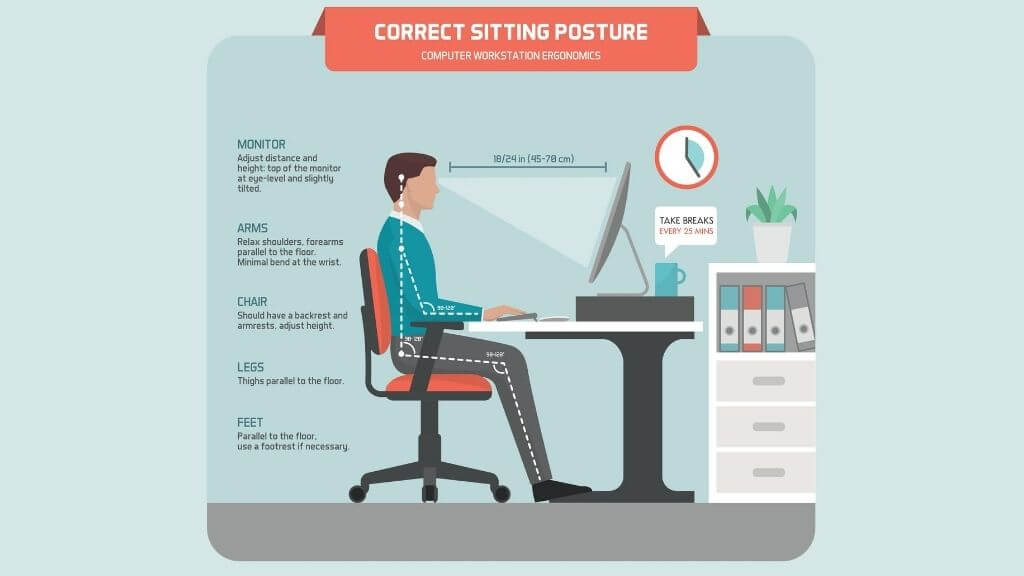4 Easy Ways to Improve Your Posture for a Pain-Free Back at Work
7 minute read
Keeping good posture all day can be difficult, especially if you’re not used to working those muscles that can keep your upright. Erik Peper, professor in the department of health education at San Francisco State University believes that, “we live in a world now where slouching is highly promoted because we’re sitting in chairs and our body is in a collapsed position.”
In addition to the detrimental damage caused to our spines, what most don’t know is that slouching can actually worsen our moods. Peper believes that these collapsed positions can be playing a big part in our cognitive performance and overall energy levels.
If you’ve found yourself slouching through the day and hitting that afternoon slump, then these four steps will help you work your way to an upright position.
1. Get up and Go!
As humans, we aren’t built to live a stagnant sedentary life. A number of us in the working force must sit at a desk for a whopping 40 hours a week, sometimes more!
People tend to forget the damage all our time spent sitting does to our bodies. Lounging for hours on end can not only stiffen our joints but also cause bad posture.

When continuously sitting in the same position, it puts unwanted or unnatural stress on various bones, joints, and muscles in your body, making it easy for our bodies to become tired and stiff. This in turn causes a slouch to form that can become present when both sitting and walking.
Try integrating exercise into your daily life to help rebuild those core and back muscles.
When at Work
Finding time to exercise when you’re working overtime can seem quite difficult, but you don’t have to schedule in a 3-mile run during your lunch break. While it would be ideal to walk around for several minutes at least once every hour, we know that sometimes that might be a little much.
On days like this, simply set a couple alarms throughout the day to remind yourself to get up and get moving. This can be as simple as a couple laps around the office, taking a longer route to the break room or restroom, or just getting up to stretch your back and legs.
These movements will help deliver oxygen and much-needed nutrients back into your muscles while redistributing blood throughout the body.
At Home or the Gym
Try a circuit of six posture-corrective exercises done at least once a day, but ideally done twice. The regimen includes:

♦ 30-second pec stretch on each side to ease the stiffness that comes from tight pecs that form when slouching
♦ 8 reps on each side of a bent over t-spine extension to open up the mid-back
♦ 10 reps of wall slides to strengthen mid- and upper-back
♦ 15 reps of bent over L’s strengthen rear shoulder muscles
♦ 30-second hip flexor stretch on each side to work your pelvis and lower back into its normal position
♦ 5 reps deadbugs on each side to correct pelvic position and work your core muscles
2. Take a Note or Two From Yoga
Practicing yoga doesn’t just require flexibility, it requires breath control. You’d be surprised how much breath control can actually help various forms of human life, from calming anxiety to even making for a better singer. Yoga is greatly beneficial to your health.
When slouched over a desk or phone all day, our muscles in our hip flexors become tight, eventually tilting the pelvis and damaging the curve of our lower back. But to take a truly effective deep breath, our body must be in alignment.
Your head should be resting above your chest, directly above your heart. This alignment allows your rib cage to properly move in conjunction with the contracting of your muscles.

When you’re feeling a deep slouch forming, remember to pay attention to your breathing and move your body into the proper alignment to take the deepest breath you can while engaging your core muscles, then hold the breath for a few seconds and release.
Not only does this rest your posture, it also sends a burst of energy that will kick you out of that afternoon slump!
3. Pillow Talk
If you can’t remember the last time you got a new pillow or you’re forced to sleep with an arm underneath your head because your pillow is paper thin, then it just might be time for you to face the music and invest in something a little more supportive. Getting good sleep matters.
If you’re a back or side sleeper, you might need a thicker pillow to fill the gap that comes between your head and the bed. However, Harvard Health indicates that when sleeping on your back and utilizing a pillow that is too thick or firm can cause neck issues because it is pushing the head too far forward, causing even more alignment issues that can worsen posture.
4. Readjust
Setting regular reminders throughout the day to check your posture and readjust is the simple step that many people forget. For the most part, your body will tell you when your posture isn’t at it’s best in the form of soreness. Of course, it’d be best if it wasn’t ever allowed to get that far.

| Related: Lower Back Exercises & Stretches for a Strong, Pain-Free Back |
Remember to check and adjust your body when needed. To find your optimal seated position, simply sit on your hands, palm down. Move your body on top of them until the weight is evenly distributed between both palms and remove your hands.
This simple movement aligns your shoulders, spine and pelvis in the positions catered to your body.
The Bottom Line
Fixing that slouch isn’t going to be an easy task but your body and mind will thank you for the work you’ve put into bettering your posture. The benefits that come with better posture should far outweigh the steps it’ll take to get there.
Besides, you’ll soon see that the more you practice, the easier it will become.












